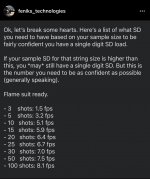This is a follow-up to an earlier thread of mine. Remington 700 rifle in 308…reloading 185 grain Berger Juggernaut with Varget and H4895, Lapua brass, CCI primers. Shooting at 100 yards off bench, bipod and bags.
I’m trying to develop a load for that bullet. Last week I loaded 11 rounds with both H4895 and Varget at .2 grain increments to look for a ”node” of similar velocities. The Varget…loaded with 11 rounds from 43 to 45 grains (in .2 grain increments) yielded a group for all 11 rounds at different velocities…of 1.25 inches at 100 yards.
Yesterday was quite different.
The first photo is 42.9 grains of H4895. SIX rounds in 7/16 of an inch. Ave 2624 FPS, SD = 18, ES = 48. I love the group size but don’t like the SD and ES if stretching out to long range.
The second photo is 44.4 grains of Varget. Five rounds in 1.5 inches. Ave speed 2579 FPS, SD = 7, ES = 20. Lousy group (worse than with 11 rounds loaded at different charge weights) but acceptable SD and ES.
To add to the information/confusion, with 41.7 grains of H4895 I had another six shot group at ¾ inch but an SD of 13 and ES of 34.
Why the heck is such a GREAT group coming from such lousy SD and ES? And vice versa, such a modest group from a very nice SD and ES?
What gives?
Last edited:


